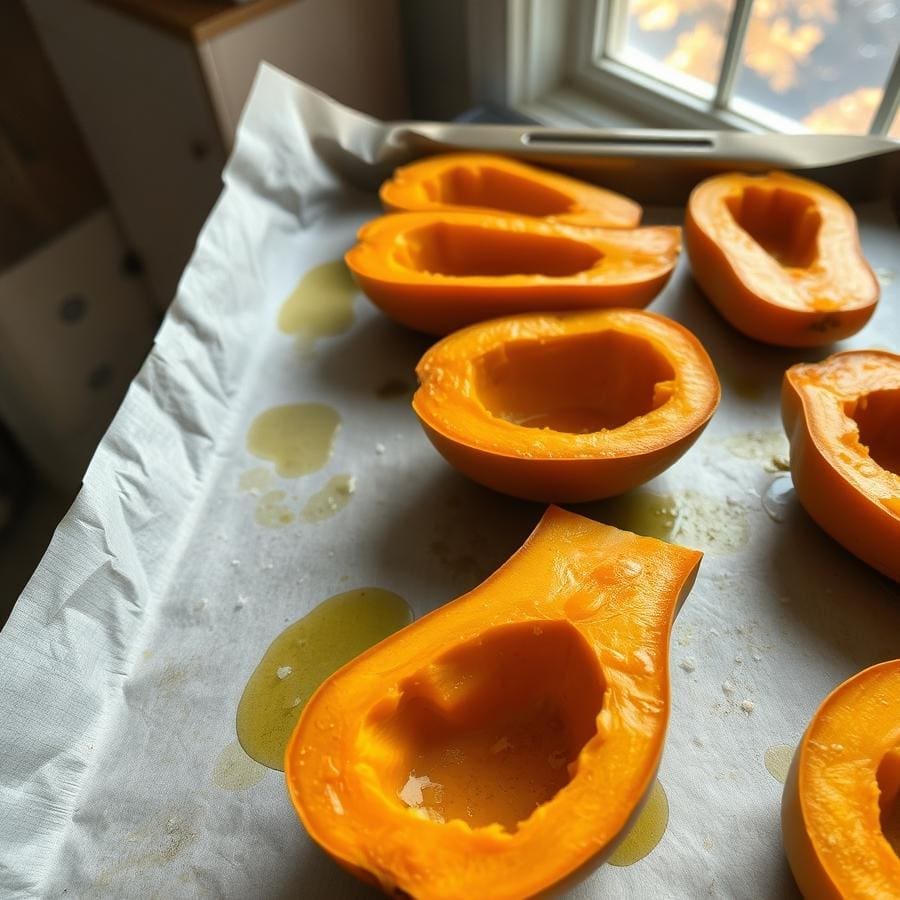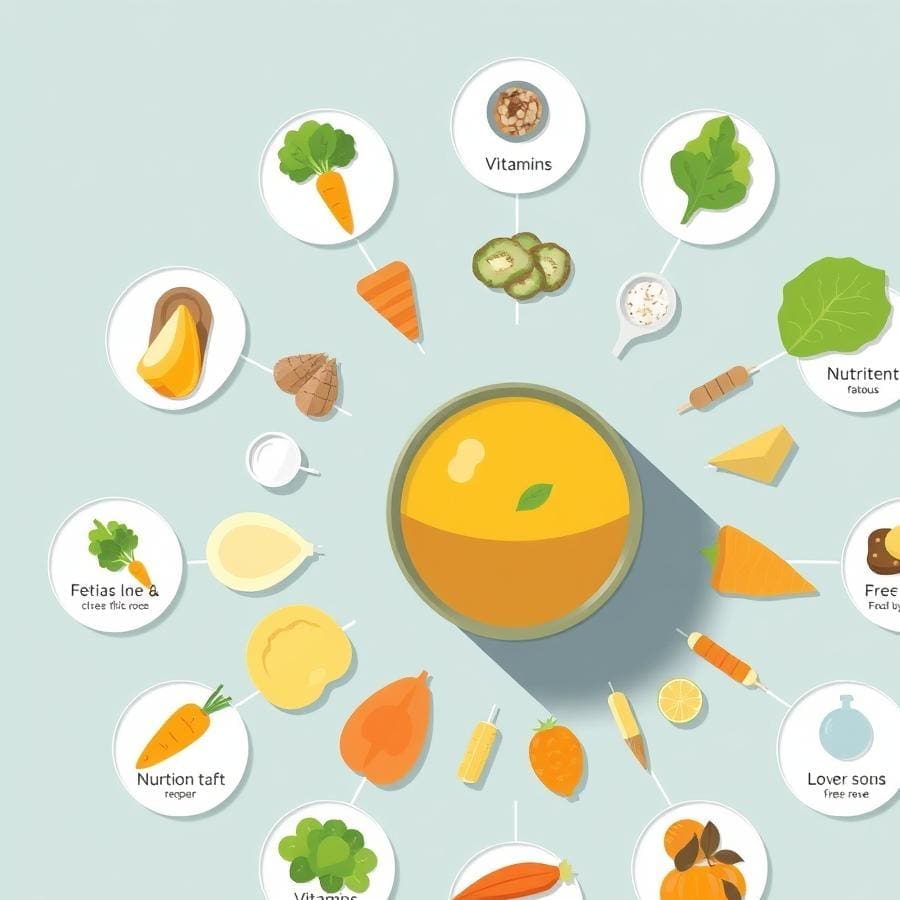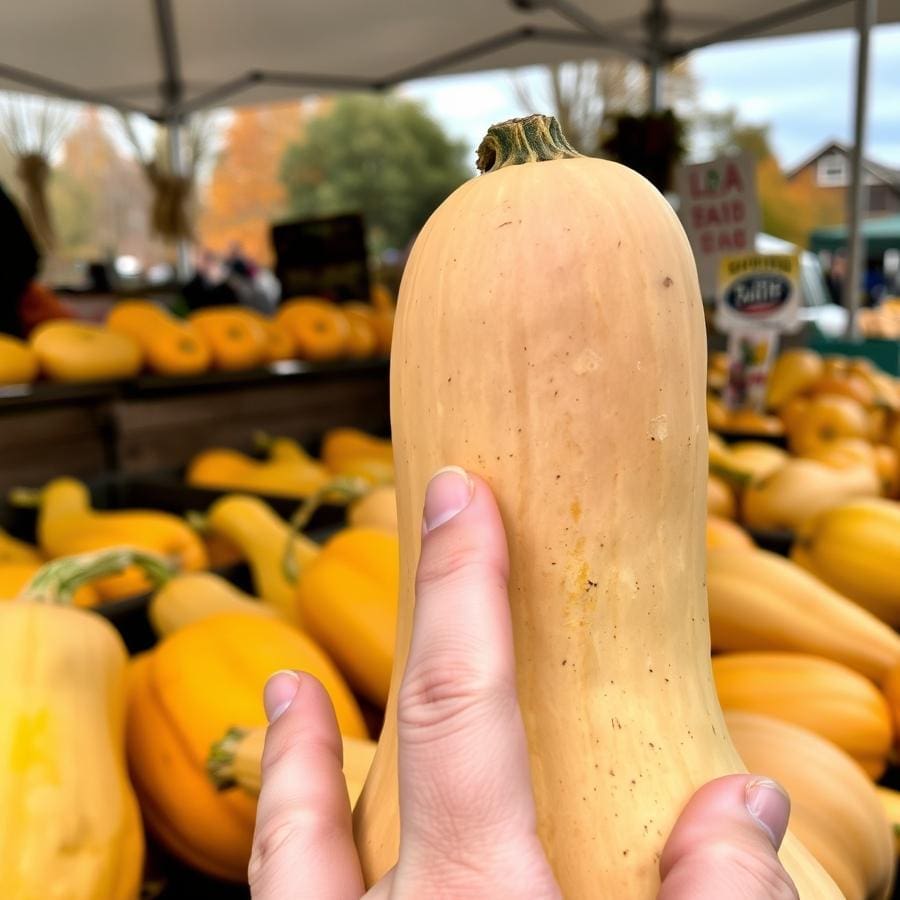Easy Vegan Butternut Squash Soup (No Peeling Required! Creamy & Comforting)

As the leaves turn and the air chills, nothing beats a bowl of warm, velvety vegan butternut squash soup to chase away the autumn blues. This recipe is my go-to for effortless comfort food that’s as nourishing as it is delicious.
Drawing from years of creating plant-based meals, I’ve perfected a method that skips the tedious peeling and chopping, letting the squash’s natural sweetness shine through roasting. Infused with ginger, nutmeg, and a touch of maple, it’s a symphony of fall flavors that supports your wellness goals with beta-carotene-rich squash for immune health and eye support.
Whether you’re a vegan newbie or a seasoned home cook, this soup delivers satisfaction in every spoonful. Plus, it’s versatile—serve it as a starter, main, or meal prep staple.
Let’s dive into why this recipe will become your seasonal favorite and how to make it with confidence.
- Why This Vegan Butternut Squash Soup Stands Out
- The Nutritional Power of Butternut Squash
- How to Choose the Best Butternut Squash
- Ingredients for This Creamy Vegan Soup
- Step-by-Step: How to Make Vegan Butternut Squash Soup
- Expert Tips for Perfect Results Every Time
- Flavor Variations to Customize Your Soup
- Serving Suggestions and Pairings
- Storage, Freezing, and Meal Prep Tips
- Frequently Asked Questions
- Nutritional Breakdown and Health Insights
- Conclusion
Why This Vegan Butternut Squash Soup Stands Out

What sets this soup apart isn’t just its simplicity—it’s the thoughtful balance of flavors and textures that make it irresistible. The roasting technique caramelizes the squash’s edges, intensifying its nutty sweetness without added sugars dominating.
Warm spices like nutmeg and ginger add a gentle heat that warms you from the inside out, while coconut milk lends creaminess without dairy. For busy lifestyles, the no-peel method saves time and effort, making it ideal for weeknight dinners or batch cooking.
As a registered dietitian specializing in plant-based nutrition, I appreciate how this recipe aligns with sustainable eating: butternut squash is seasonal, affordable, and nutrient-dense, providing fiber for gut health and antioxidants for overall vitality. Studies from the Journal of Nutrition highlight how squash’s carotenoids combat oxidative stress, supporting long-term wellness.
You’ll find yourself reaching for seconds, not just for taste, but for the nourishing hug it gives your body.
The Nutritional Power of Butternut Squash

Butternut squash isn’t just a pretty orange vegetable—it’s a nutritional powerhouse that fits perfectly into a balanced, vegan diet. One cup of cooked squash delivers over 400% of your daily vitamin A needs through beta-carotene, which research from the National Institutes of Health links to improved immune function and reduced inflammation.
It’s also rich in vitamin C for collagen production and skin health, plus potassium for heart support. With 5 grams of fiber per serving, it aids digestion and keeps you full longer, making this soup a smart choice for weight management.
The added ginger offers anti-nausea benefits, backed by a 2019 meta-analysis in Food Science & Nutrition, while nutmeg provides trace minerals like manganese for bone health. This recipe keeps calories modest at around 200 per serving, focusing on whole foods for sustained energy without blood sugar spikes.
Incorporating it regularly can enhance your fall wellness routine, promoting better sleep and mood through its comforting, tryptophan-boosting qualities.
How to Choose the Best Butternut Squash

Selecting ripe butternut squash ensures the sweetest, most flavorful soup. Look for squash with a uniform tan or beige color—avoid any with green patches, which indicate underripeness.
The skin should be firm and smooth, free from soft spots, cuts, or mold; a heavy squash for its size means it’s dense and full of flesh. Check the stem: it should be dry and corky, not moist.
Size-wise, opt for 2-3 pounds for even roasting—larger ones can be tougher. If buying pre-cut, ensure the flesh is bright orange and moist, not dry.
Pro tip: locally sourced or organic squash often tastes superior due to fresher harvest. According to the USDA, peak season from September to November maximizes nutrient density, so stock up at farmers’ markets for the best quality.
This simple selection process sets your soup up for success from the start.
Ingredients for This Creamy Vegan Soup

Gathering the right ingredients is key to that signature creamy texture and depth of flavor. You’ll need one large butternut squash (about 3 pounds), halved and roasted.
For the base: 3 tablespoons olive oil total (2 for roasting, 1 for sautéing), salt, pepper, 1/2 small sweet onion chopped, 3 garlic cloves minced. Sweeten naturally with 2 teaspoons pure maple syrup—it pairs beautifully with the squash’s nuttiness.
Spices include 1 teaspoon salt, 1/4 teaspoon each ground nutmeg and ginger (or fresh for more zing), and black pepper to taste. Liquid components: 3 cups vegetable broth, plus extra for thinning.
For serving: full-fat coconut milk drizzle. Substitutions?
Use agave for maple if needed, or pumpkin for squash in a pinch. All pantry staples, ensuring this recipe is accessible and adaptable to your kitchen.
Step-by-Step: How to Make Vegan Butternut Squash Soup

This recipe comes together in about 75 minutes, with minimal hands-on time. Start by preheating your oven to 425°F and lining a baking sheet with parchment.
Halve the squash lengthwise, scoop out seeds, place cut-side up, drizzle with 2 tablespoons olive oil, and season with salt and pepper. Flip cut-side down and roast for 50-60 minutes until fork-tender.
Meanwhile, heat 1 tablespoon olive oil in a pot over medium. Sauté chopped onion for 4-5 minutes until translucent, add minced garlic for 1 minute.
Cool the squash slightly, then scoop flesh into a blender with the onion-garlic mixture, maple syrup, salt, nutmeg, ginger, and 3 cups broth. Blend until smooth—about 1-2 minutes.
If needed, warm in the pot. Taste and adjust seasoning.
Serve hot with coconut milk swirl. For safety, use a high-speed blender and vent steam.
Expert Tips for Perfect Results Every Time

To elevate your soup, roast the squash a tad longer for deeper caramelization—watch for golden edges. For extra creaminess without more coconut, add a boiled potato during blending; it thickens naturally.
If using fresh ginger (1 tablespoon grated), sauté it with the garlic for infused flavor. Blender too full?
Work in batches to avoid spills. For a silkier texture, strain through a fine mesh after blending.
As a wellness expert, I recommend pairing with vitamin C-rich sides like kale salad to boost beta-carotene absorption, per Harvard Health guidelines. These tweaks make the recipe foolproof, even for beginners, ensuring consistent, restaurant-quality results.
Flavor Variations to Customize Your Soup

Keep things exciting by tweaking the base recipe. For a spicy kick, add 1/2 teaspoon chipotle powder or diced jalapeño during sautéing—great for metabolism support, as capsaicin aids thermogenesis per a 2020 study in Appetite journal.
Go herby with fresh sage: fry 4-5 leaves in the oil before onions for an earthy note. Sweeten it up with roasted apples blended in for a harvest twist.
For umami, stir in white miso paste post-blend. Creamy apple-cider version?
Swap half the broth for cider. These variations maintain the vegan integrity while allowing personalization, helping you build sustainable eating habits through experimentation.
Serving Suggestions and Pairings

This soup shines as a standalone meal but pairs beautifully with hearty accompaniments. Dip crusty sourdough or vegan cornbread for texture contrast— the bread soaks up the creaminess perfectly.
For a full dinner, serve alongside roasted veggies like Brussels sprouts or a quinoa salad. As a starter, it complements vegan pot pie or stuffed peppers.
Top with pepitas for crunch, or pomegranate seeds for tart pop. In colder months, it’s ideal before a hearty coconut curry lentil soup.
Nutritionally, balancing with protein-rich sides like a simple Italian chickpea soup ensures a complete meal, supporting muscle repair as outlined by the Academy of Nutrition and Dietetics.
Storage, Freezing, and Meal Prep Tips

This soup is meal-prep gold: portion into airtight containers for fridge storage up to 4 days. For freezing, cool completely, then freeze in bags or jars for 3 months—thaw overnight and reheat gently to preserve texture.
Microwave in 30-second bursts or stovetop over low heat, stirring in fresh coconut milk if separated. Avoid repeated freezing to maintain nutrients; vitamin C is heat-sensitive, so minimal reheating is best.
This makes it perfect for busy weeks, aligning with habit-building for consistent plant-based eating.
Frequently Asked Questions

- Do I need to peel the butternut squash? No, roasting loosens the skin for easy scooping—saves time and hassle.
- How can I thin the soup if it’s too thick? Add vegetable broth or coconut milk gradually while blending or reheating.
- Can I use frozen squash? Yes, roast from frozen for 10 extra minutes, then proceed.
- Is an Instant Pot version possible? Absolutely—sauté aromatics, add squash and broth, pressure cook 8 minutes, then blend.
- How do I make it spicier? Incorporate fresh ginger or cayenne for adjustable heat.
- Is this soup gluten-free? Yes, all ingredients are naturally gluten-free; check broth labels.
Nutritional Breakdown and Health Insights

Per serving (1/4 recipe): 203 calories, 28g carbs, 2g protein, 11g fat, 4g fiber, 8g sugar. It’s low in saturated fat but high in vitamins A (20,000+ IU) and C (41mg), supporting vision and immunity.
The fiber promotes gut health, while low glycemic index aids stable energy. Compared to creamy non-vegan versions, this cuts calories by 30% without sacrificing taste.
For personalized advice, consult a dietitian—especially if managing diabetes, as maple adds natural sugars.
Conclusion
This vegan butternut squash soup is more than a recipe—it’s a simple way to embrace fall’s bounty while nurturing your body and soul. With its ease, versatility, and health perks, it’s a staple that fosters mindful eating and joyful cooking.
Experiment with the variations, share with loved ones, and savor the warmth. For more plant-powered inspiration, explore my collection of seasonal soups, like this cozy creamy potato leek soup.
Happy cooking!
